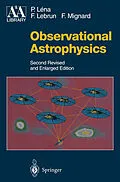Written specifically for physicists and graduate students in astronomy, this textbook focuses on astronomical observation and on the basic physical principles that astronomers use to conceive, build and exploit their instruments at their ultimate limits in sensitivity or resolution. This second edition has been entirely restructured and almost doubled in size, in order to improve its clarity and to account for the great progress achieved in the last 15 years. It deals with ground-based and space-based astronomy and their respective fields. It presents the new generation of giant ground-based telescopes, with the new methods of optical interferometry and adaptive optics, and also the ambitious concepts behind planned space missions for the next decades. Avoiding particulars, it covers the whole of the electromagnetic spectrum, and touches upon the "new astronomies" becoming possible with gravitational waves and neutrinos.
Klappentext
This second edition has been entirely restructured and almost doubled in size, in order to improve clarity and account for the great progress achieved in the field over the last 15 years.
"This is not a handbook for observers. It is a broader reference for students, active researchers, and anyone who wants a detailed look at the tools of modern astronomy..." -PHYSICS TODAY
Inhalt
1. Astrophysical Information.- 2. The Earth's Atmosphere and Space.- 3. Radiation and Photometry.- 4. Telescopes and Images.- 5. Spectral Analysis.- 6. The Signal in Astronomy.- 7. Detectors.- 8. Space-Time Reference Frames.- Appendix A. Fourier Transforms.- A.1 Definitions and Properties.- A.1.1 Definitions.- A.1.2 Some Properties.- A.1.3 Important Special Cases in One Dimension.- A.1.4 Important Special Cases in Two Dimensions.- A.1.5 Important Theorems.- A.2 Physical Quantities and Fourier Transforms.- A.3 Wavelets.- Appendix B. Random Processes and Variables.- B.1 Random Variables.- B.2 Random or Stochastic Processes.- B.3 Physical Measurements and Estimates.- B.3.1 An Example of Estimation: Law of Large Numbers.- B.3.2 Estimating the Moments of a Process.- B.3.3 Estimation and Bias.- Appendix C. Physical and Astronomical Constants.- Appendix D. Tables of Space Missions.- Appendix E. Astronomy on the World Wide Web.- Appendix F. Acronyms and Abbreviations.
